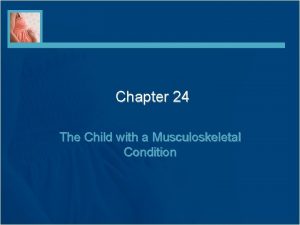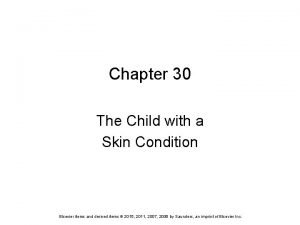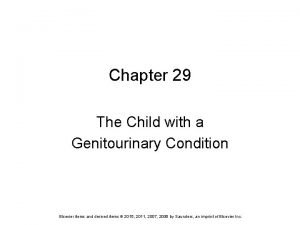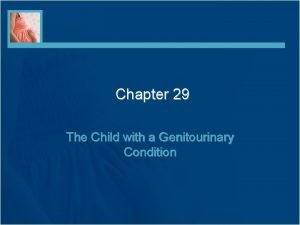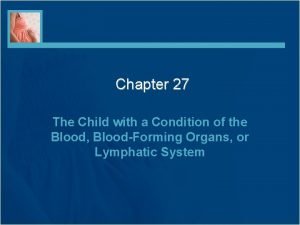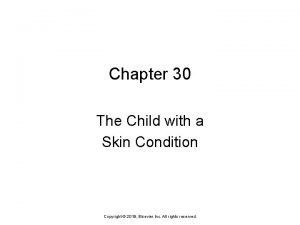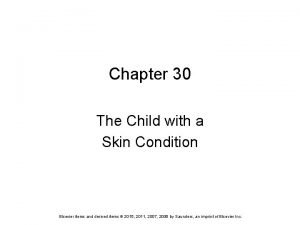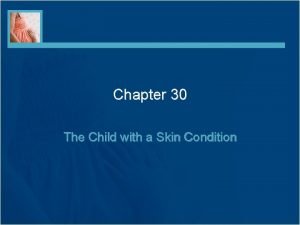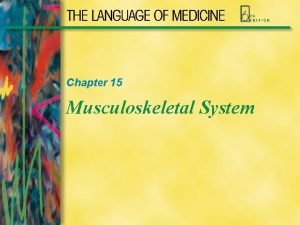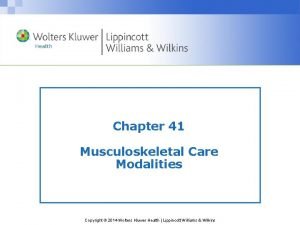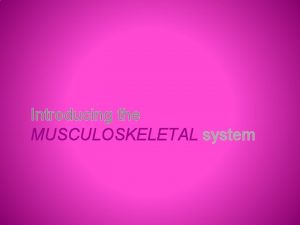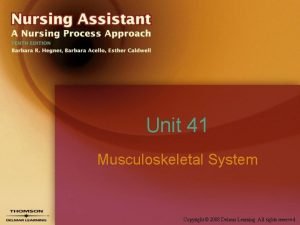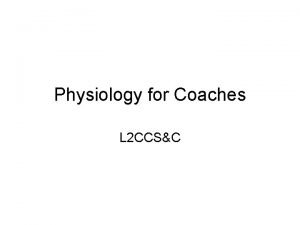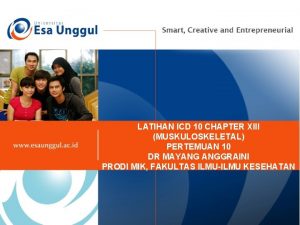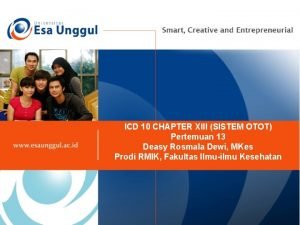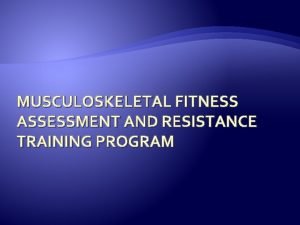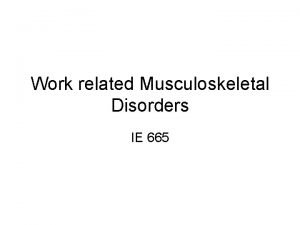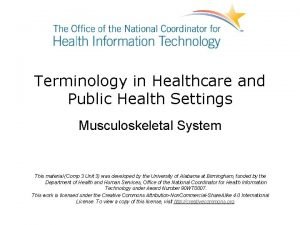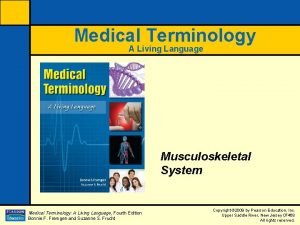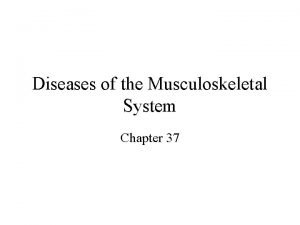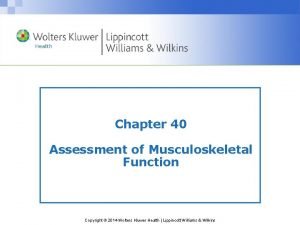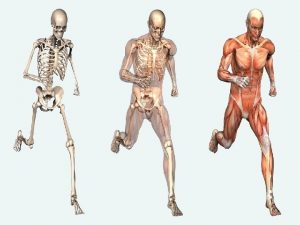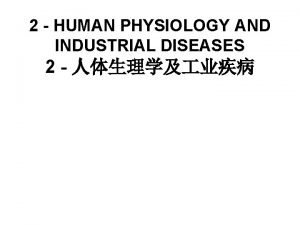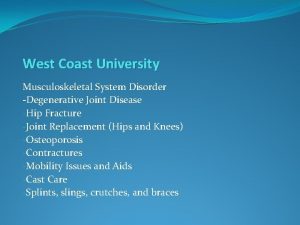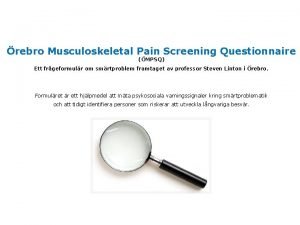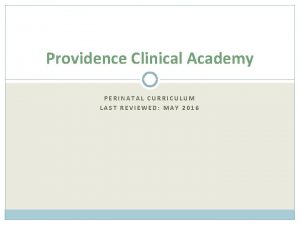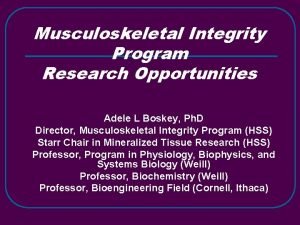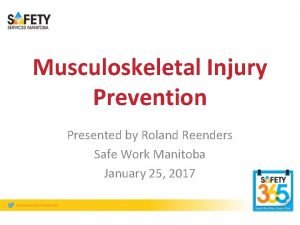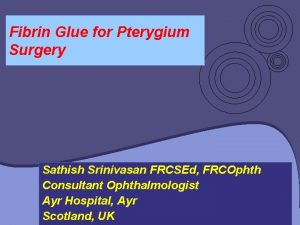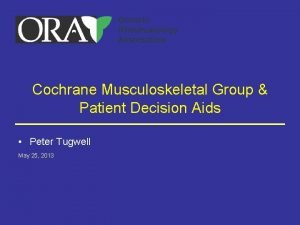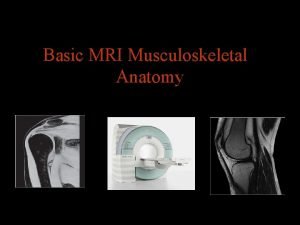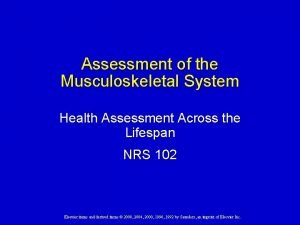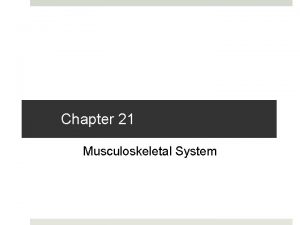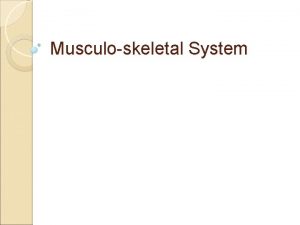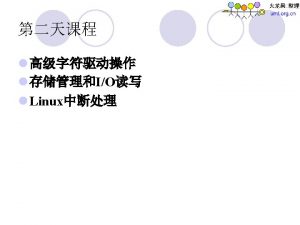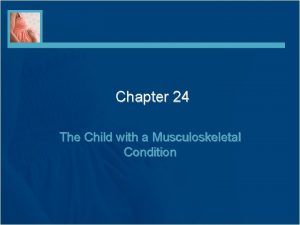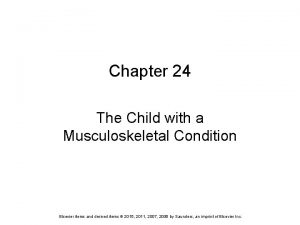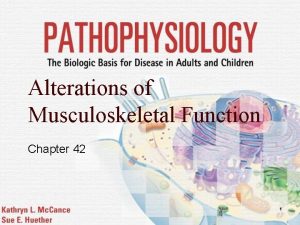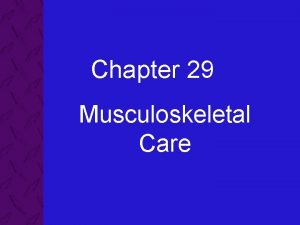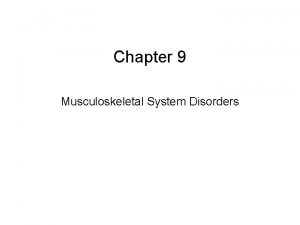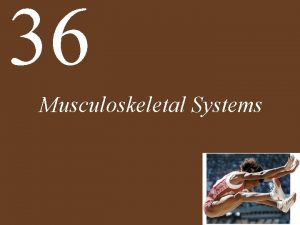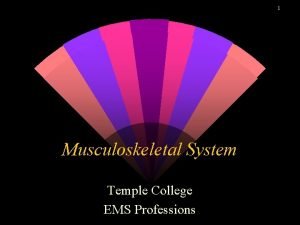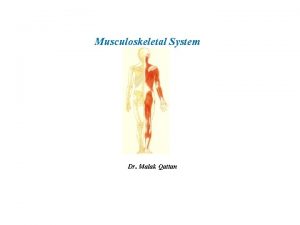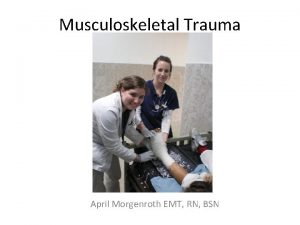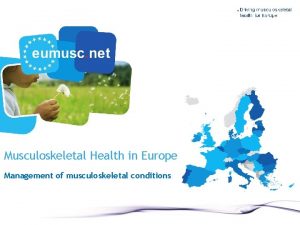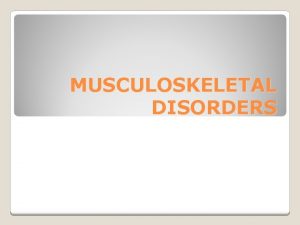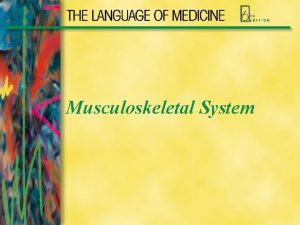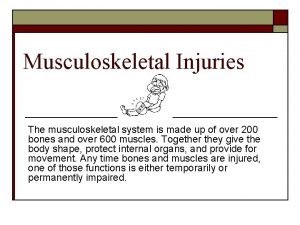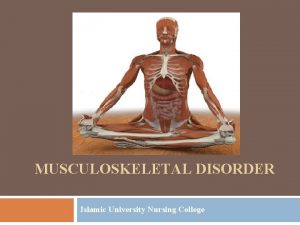Chapter 24 The Child with a Musculoskeletal Condition








































- Slides: 40

Chapter 24 The Child with a Musculoskeletal Condition Copyright © 2019, Elsevier Inc. All rights reserved.

Characteristics of the Child’s Musculoskeletal System Bone is not completely ossified. Epiphyses are present. Periosteum is thick. Ø Produces callus more rapidly than in an adult Lower mineral content of the child’s bone and greater porosity increases the bone’s strength. Bone overgrowth is common in healing fractures of children younger than 10 years of age because of the presence of the epiphysis and hyperemia caused by the trauma. Copyright © 2019, Elsevier Inc. All rights reserved. 2

Overview and Observation Muscular and skeletal systems work together. Arises from the mesoderm in the embryo Ø A great portion of skeletal growth occurs between the 4 th and 8 th weeks of fetal life. Supports the body and provides for movement Locomotion develops gradually and in an orderly manner. Copyright © 2019, Elsevier Inc. All rights reserved. 3

Diagnostic Tests Radiographic studies include Ø Bone scans Ø CT scans Ø MRI scans Ø Ultrasound Laboratory tests include Ø CBC Ø ESR Ø Human leukocyte antigen (HLA) B-27 Copyright © 2019, Elsevier Inc. All rights reserved. 4

Treatments Treatment ØArthroscopy ØBone biopsy ØTraction ØCasting ØSplints Copyright © 2019, Elsevier Inc. All rights reserved. 5

Principles of Managing Soft Tissue Injuries Include the Following: Rest Ice Compression Elevation Copyright © 2019, Elsevier Inc. All rights reserved. 6

Soft tissue injuries Contusion: a tearing of subcutaneous tissue resulting in hemorrhage, edema and pain Hematoma: a raised ecchymosis; blood escaped into the tissue Sprain: when the ligament is torn or stretched away from the bone; there may be damage to blood vessels, muscles and nerves; may be swelling and pain Strain: a microscopic tear to the muscle or tendon resulting in edema and pain Copyright © 2019, Elsevier Inc. All rights reserved. 7

Traumatic Fractures A fracture is a break in a bone and is mainly caused by accident. Characterized by Ø Pain, tenderness on movement, and swelling Ø Discoloration, limited movement, and numbness may also occur. Fractures heal more rapidly in children. The child’s periosteum is stronger and thicker and less stiffness on mobilization. Injury to the cartilaginous epiphysis is serious if it happens during childhood. Ø May interfere with longitudinal growth of the bone Copyright © 2019, Elsevier Inc. All rights reserved. 8

Fractures Compound: a wound in the skin accompanies the fracture Greenstick: an incomplete fracture; often happens to children because the bones are not fully ossified Spiral: caused by a forceful twisting motion; almost always indicative of abuse Copyright © 2019, Elsevier Inc. All rights reserved. 9

Physical findings Pain Crepitus Deformity Edema Ecchymosis Warmth or redness Decreased mobility Copyright © 2019, Elsevier Inc. All rights reserved. 10

Fractures Copyright © 2019, Elsevier Inc. All rights reserved. 11

Spiral fracture Copyright © 2019, Elsevier Inc. All rights reserved. 12

Traction Bryant traction Buck skin traction Russell traction Copyright © 2019, Elsevier Inc. All rights reserved. 13

Casts and Splints Can be made from a variety of materials Child is at increased risk for Ø Impaired skin integrity Ø Neurovascular checks Ø Compartment syndrome • Progressive loss of tissue perfusion because of an increase in pressure caused by edema or swelling that presses on the vessels and tissues • If not carefully monitored, significant complications can occur. Copyright © 2019, Elsevier Inc. All rights reserved. 14

Nursing Care of a Child in a Cast Material used determines positioning of effected extremity for up to 72 hours. Elevate effected extremity on a pillow. Perform frequent neurovascular checks. Teach cast care and how to support cast, safe transfers to or from chair or bed, how to use crutches safely, and when a cast is too loose or too tight. Copyright © 2019, Elsevier Inc. All rights reserved. 15

Clubfoot Risk factors: may be hereditary or may be presence of other syndromes Affected foot is smaller and shorter in length than normal foot Diagnosis: can be detected on prenatal ultrasound Treated with therapeutic serial castings Cast care; neurovascular checks Copyright © 2019, Elsevier Inc. All rights reserved. 16

Developmental dysplasia of the hip (DDH) Risk factors: Ø Firstborn Ø Female Ø Family history Ø Breech presentation Ø Increased birth weight Infant will show asymmetry of gluteal and thigh folds Pavlik harness Copyright © 2019, Elsevier Inc. All rights reserved. 17

Pavlik harness Copyright © 2019, Elsevier Inc. All rights reserved. 18

Spina bifida Failure of osseous spine to close Meningocele: sac contains spinal fluid and meninges Myelomeningocele: sac contains spinal fluid, meninges, and nerves Maternal malnutrition/folic acid deficiency Perform normal neonatal assessment, as well as assessment of neuro disability May have mobility as well as bowel/bladder issues Copyright © 2019, Elsevier Inc. All rights reserved. 19

Spina bifida Copyright © 2019, Elsevier Inc. All rights reserved. 20

Osteomyelitis An infection of the bone that generally occurs in children younger than 1 year of age and in those between 5 and 14 years of age Staph aureus the most common culprit May be preceded by injury to bone, burn, surgery, furuncle, impetigo, or abscessed teeth Copyright © 2019, Elsevier Inc. All rights reserved. 21

Osteomyelitis Diagnosis: Ø Elevation in WBC, erythrocyte sedimentation rate (ESR or sed rate) Ø Bone scan, aspirated culture Treatment and nursing care: Ø Prompt and vigorous treatment is necessary Ø IVABs for 4 -6 weeks Ø Pain relief Ø Surgery may be necessary for pus or bone necrosis Copyright © 2019, Elsevier Inc. All rights reserved. 22

Duchenne’s or Becker Muscular Dystrophy (MD) (1 of 2) Group of disorders in which progressive muscle degeneration occurs Ø Duchenne MD is most common • Onset is generally between 2 and 6 years of age • A history of delayed motor development during infancy may be evidenced. • Calf muscle becomes hypertrophied • Progressive weakness and frequent falls • Sex-linked; occurs only in boys Copyright © 2019, Elsevier Inc. All rights reserved. 23

Duchenne or Becker Muscular Dystrophy (MD) (2 of 2) Diagnostics Ø Marked increase in blood creatine phosphokinase level Ø Muscle biopsy reveals a degeneration of muscle fibers replaced by fat and connective tissue. • Myelogram shows decreases in the amplitude and duration of motor unit potentials. Ø ECG abnormalities are also common. Treatment is mainly supportive to prevent contractures and preserve quality of life Copyright © 2019, Elsevier Inc. All rights reserved. 24

Slipped Femoral Capital Epiphysis Also known as coxa vera Spontaneous displacement of the epiphysis of the femur Occurs most often during rapid growth of the preadolescent and is not related to trauma Symptoms include thigh pain and a limp or the inability to bear weight on the involved leg. Buck extension traction is used to minimize further slippage until surgical intervention can take place. Copyright © 2019, Elsevier Inc. All rights reserved. 25

Legg-Calvé-Perthes Disease (Coxa Plana) One of a group of disorders called the osteochondroses in which the blood supply to the epiphysis, or end of the bone, is disrupted Ø Tissue death that results from inadequate blood supply is termed avascular necrosis. Ø Affects the development of the head of the femur More common in boys 5 to 12 years of age Healing occurs spontaneously over 2 to 4 years May have marked distortion of head of femur Self-limiting Degenerative arthritis may occur later in life Copyright © 2019, Elsevier Inc. All rights reserved. 26

Osteosarcoma Primary malignant tumor of the long bones Ø Mean age of onset is 10 to 15 years of age Ø Children who have had radiation therapy for other types of cancer and children with retinoblastoma have a higher incidence of this disease. Metastasis occurs quickly because of the high vascularity of bone tissue. Ø Lungs are primary site of metastasis. Copyright © 2019, Elsevier Inc. All rights reserved. 27

Manifestations Pain and swelling at the siite Pathological fractures may occur later Diagnosis: complete physical, CT and bone scan Treatment: surgical, with chemo and radiation Amputation may be necessary Copyright © 2019, Elsevier Inc. All rights reserved. 28

Ewing’s Sarcoma Malignant growth that occurs in the marrow of the long bones. Mainly occurs in older school-age children and early adolescents When metastasis is present, prognosis is poor. Primary sites for metastasis are lungs and long bones. Treatment Ø Radiation therapy and chemotherapy Copyright © 2019, Elsevier Inc. All rights reserved. 29

Juvenile Idiopathic Arthritis (JIA) (1 of 2) Formerly known as juvenile rheumatoid arthritis (JRA) Most common arthritic condition of childhood Systemic inflammatory disease involving joints, connective tissues, and viscera No specific tests or cures for JIA Duration of symptoms is important, particularly if they have lasted longer than 6 weeks Copyright © 2019, Elsevier Inc. All rights reserved. 30

Juvenile Idiopathic Arthritis (JIA) (2 of 2) Three distinct methods of onset Ø Systemic (or acute febrile) Ø Polyarticular Ø Pauciarticular Treatment: reduce pain and swelling, promote mobility and preserve joint function PT and OT; multidisciplinary treatment team Child may have remissions and exacerbations Copyright © 2019, Elsevier Inc. All rights reserved. 31

Torticollis (Wry Neck) Neck motion is limited because of shortening of the sternocleidomastoid muscle Can be congenital (most common) or acquired Ø Acute or chronic Ø Associated with breech and forceps delivery • May be seen in conjunction with other birth defects, such as congenital hip dysplasia Copyright © 2019, Elsevier Inc. All rights reserved. 32

Scoliosis More common in girls Two types Ø Functional—caused by poor posture Ø Structural—caused by changes in the shape of the vertebrae or thorax • Usually accompanied by rotation of the spine. • Hips and shoulders may appear to be uneven. Copyright © 2019, Elsevier Inc. All rights reserved. 33

Scoliosis Symptoms develop slowly and are not painful Hips or shoulders may appear uneven Treatment is aimed at correcting the curvature and preventing more severe scoliosis Milwaukee brace Surgery in severe cases Screening important; done in schools Copyright © 2019, Elsevier Inc. All rights reserved. 34

Sports Injuries Sports-specific examinations are given for those involved in strenuous activity on entry into middle school or high school. Common injuries include Ø Concussion Ø “Stingers” or “burners” Ø Injured knee Ø Sprain or strained ankle Ø Muscle cramps Ø Shin splints Copyright © 2019, Elsevier Inc. All rights reserved. 35

Family Violence Affects children of all social classes Includes Ø Spousal and child abuse Ø Neglect Ø Maltreatment Copyright © 2019, Elsevier Inc. All rights reserved. 36

Child Abuse Types of child abuse Ø Emotional abuse: verbal acts destroys self-esteem Ø Emotional neglect: intentional omission of verbal or behavioral actions Ø Sexual abuse: involves acts performed on a child for sexual gratification of the adult Ø Physical neglect: failure to provide for basic needs Ø Physical abuse: deliberate infliction of injury Copyright © 2019, Elsevier Inc. All rights reserved. 37

Federal Laws and Agencies Reporting suspected abuse or neglect Ø All persons who report suspected abuse or neglect are given immunity from criminal prosecution and civil liability if the report is made in good faith. Know what your state laws mandate for health care providers. Copyright © 2019, Elsevier Inc. All rights reserved. 38

Nursing Interventions for Abused and Neglected Children and Adolescents Teach child Ø Anxiety-reducing techniques Ø Assertiveness skills Ø Enhance coping mechanisms Assist child in Ø Managing feelings Ø Developing problem-solving skills Ø Value building and clarification Copyright © 2019, Elsevier Inc. All rights reserved. 39

Cultural and Medical Issues A culturally sensitive history is essential in assessing children suspected to be victims of abuse. Some cultural practices can be interpreted as physical abuse if the nurse is not culturally aware of folk-healing and ethnic practices. Document all signs of abuse and interactions as well as verbal comments between the child and parent. Child protective services should oversee any investigation that is warranted. Copyright © 2019, Elsevier Inc. All rights reserved. 40
 Buck's extension traction
Buck's extension traction Chapter 30 the child with a skin condition
Chapter 30 the child with a skin condition Chapter 29 the child with a genitourinary condition
Chapter 29 the child with a genitourinary condition Chapter 29 the child with a genitourinary condition
Chapter 29 the child with a genitourinary condition Chapter 27 the child with a condition of the blood
Chapter 27 the child with a condition of the blood Chapter 30 the child with a skin condition
Chapter 30 the child with a skin condition Chapter 30 the child with a skin condition
Chapter 30 the child with a skin condition Chapter 30 the child with a skin condition
Chapter 30 the child with a skin condition Geometric symbols and their meanings
Geometric symbols and their meanings The musculoskeletal system chapter 21
The musculoskeletal system chapter 21 Chapter 6 musculoskeletal system
Chapter 6 musculoskeletal system Chapter 15 musculoskeletal system practical
Chapter 15 musculoskeletal system practical Chapter 40 musculoskeletal care modalities
Chapter 40 musculoskeletal care modalities Musculoskeletal system
Musculoskeletal system Unit 41 musculoskeletal system
Unit 41 musculoskeletal system Musculoskeletal system
Musculoskeletal system Kode icd 10 bursitis genu
Kode icd 10 bursitis genu Sakita 1m45
Sakita 1m45 Musculoskeletal fitness test
Musculoskeletal fitness test Work related musculoskeletal disorders definition
Work related musculoskeletal disorders definition Musculoskeletal pronounce
Musculoskeletal pronounce Medical
Medical Diseases of the musculoskeletal system
Diseases of the musculoskeletal system Assessment of the musculoskeletal system
Assessment of the musculoskeletal system Assessment of the musculoskeletal system
Assessment of the musculoskeletal system Musculoskeletal system
Musculoskeletal system West coast musculoskeletal
West coast musculoskeletal Mpsq
Mpsq Cephalohematoma
Cephalohematoma Musculoskeletal integrity
Musculoskeletal integrity Thank you pictures for presentation
Thank you pictures for presentation Spine pathology
Spine pathology Musculoskeletal
Musculoskeletal Sathish srinivasan
Sathish srinivasan Cochrane musculoskeletal group
Cochrane musculoskeletal group Musculoskeletal mri anatomy
Musculoskeletal mri anatomy Objective data for musculoskeletal system
Objective data for musculoskeletal system Left child right child tree representation
Left child right child tree representation Hát kết hợp bộ gõ cơ thể
Hát kết hợp bộ gõ cơ thể Frameset trong html5
Frameset trong html5 Bổ thể
Bổ thể
